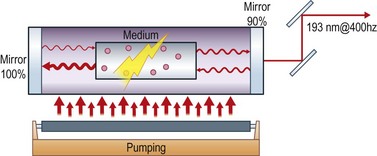CHAPTER 24 Laser technology (excimer and femto)
Introduction
The interaction of the excimer laser with corneal tissue, which was initially described in early 1980s, is the fundamental aspect of refractive surgery. Corneal photoablation with excimer laser is a safe and effective technique for the modification of corneal curvature through tissue removal in order to achieve refraction changes1,2. The latest evolution in laser refractive surgery is the use of femtosecond laser technology, which is capable of creating cuts with high precision in the corneal stroma and replaces the use of the blade in several applications of corneal surgery. Both laser technologies, excimer and femtosecond, are commercially available with platforms created to fit the current standards of refractive surgery practice.
Basic features of laser devices
A laser device consists of three fundamental elements: the optical cavity, the gain medium, and the pumping system (Fig. 24.1). The optical cavity is an arrangement of mirrors which allows the light to oscillate within it. An optical cavity can be created by two oppositely placed plane or concave mirrors. The gain medium is the material in which the process of stimulated emission takes place. It can be gas, solid, liquid, or semiconductor, and the critical properties of the emitted laser radiation depend on the material used. The gain medium generates and amplifies the radiation that travels through it guided by the mirrors of the optical cavity. The pumping system provides the necessary energy for the amplification of the laser radiation. Pumping can be either optical or electrical.
Stay updated, free articles. Join our Telegram channel

Full access? Get Clinical Tree



